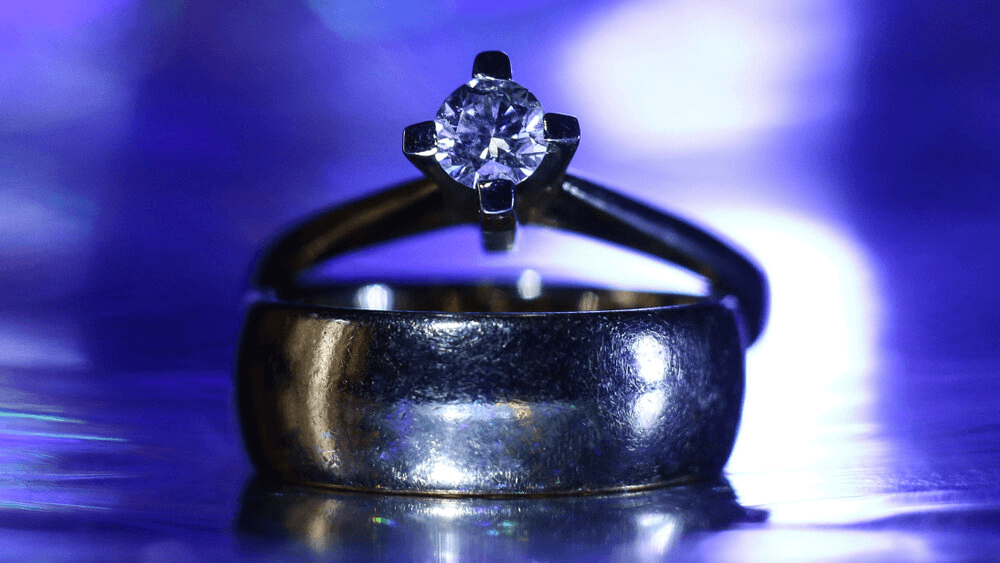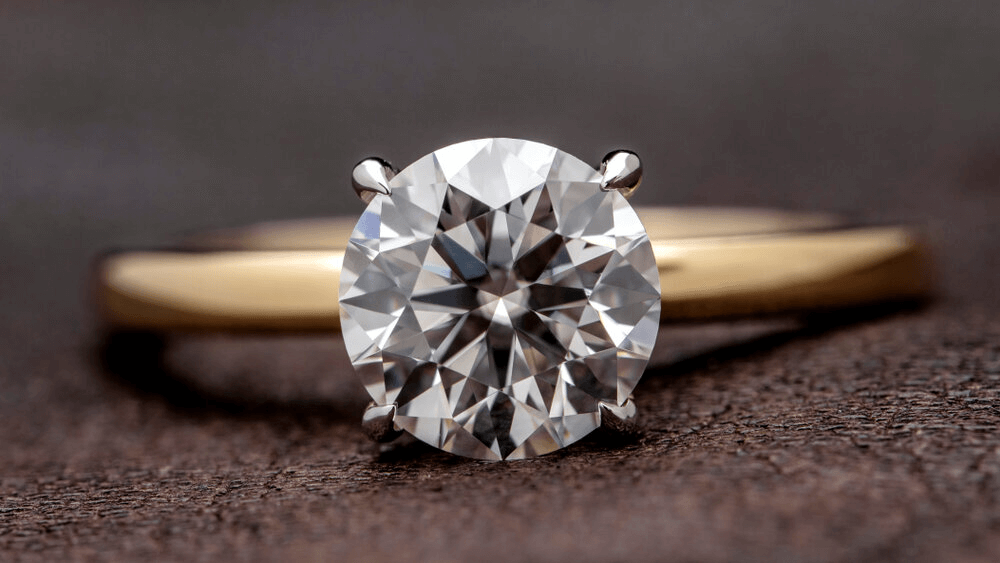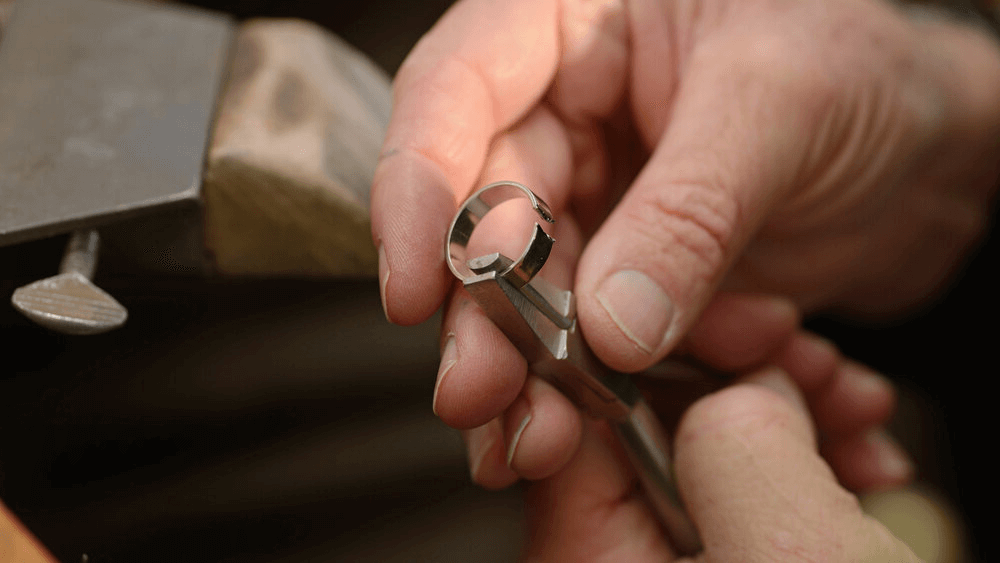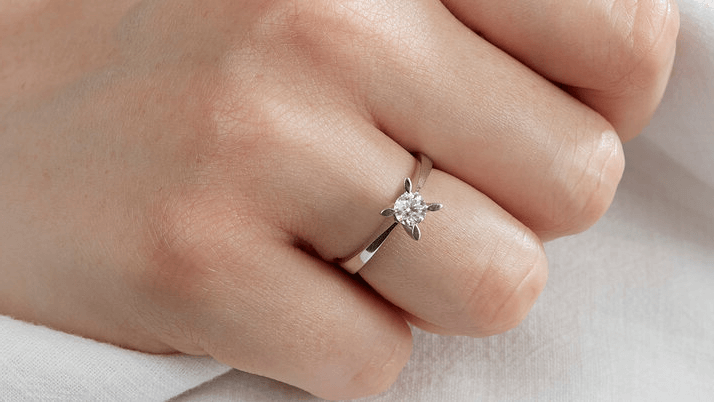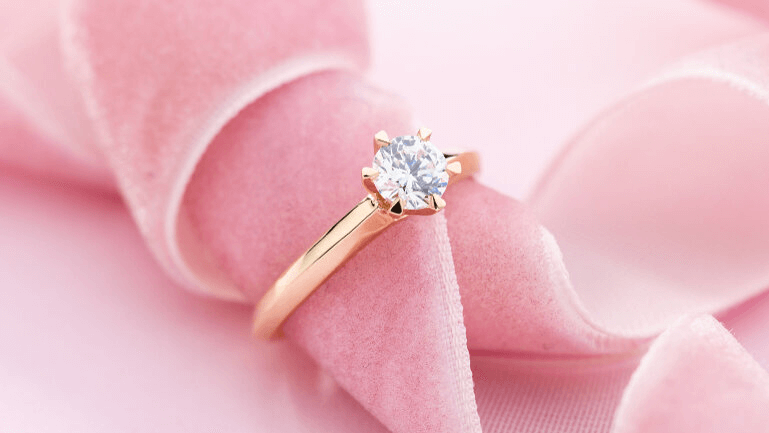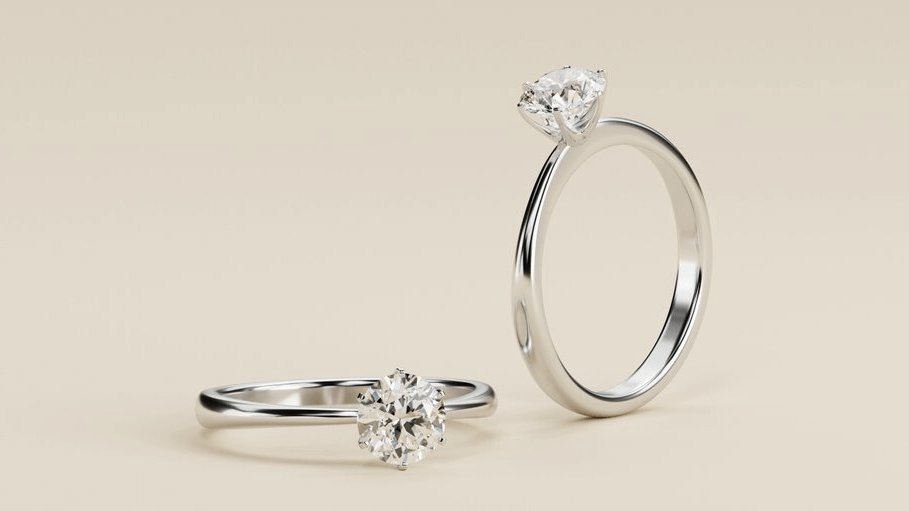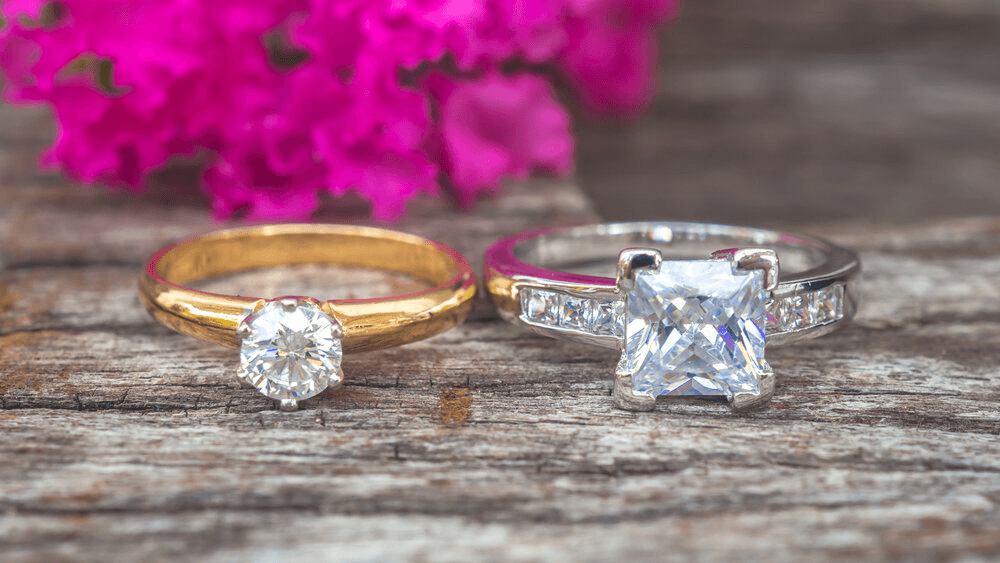Dazzle Her with White Gold Engagement Rings

By Gary A.

Edited by Olivia H.
Published Nov 14, 2021
Edited on Mar 31, 2025
With its sleek, modern appearance and timeless appeal, white gold engagement rings offer a stunning alternative to traditional yellow gold, perfectly highlighting the brilliance of any diamond.

Navigate This Guide:
- 7 Quick Tips for Buying a White Gold Diamond Engagement Ring
- Introduction
- Composition and Characteristics of White Gold
- White Gold’s Popularity in Engagement Rings
- Comparing Durability, Cost and Appearance with Platinum
- Caring for White Gold
- Our Expert Take
- 8 FAQs
Before we dive deeper into the specifics, here are some practical tips to help guide your decision-making process:
7 Quick Tips for Buying a White Gold Diamond Engagement Ring
- Tip 1: Check the Karat of the White Gold: White gold is an alloy, and its purity is measured in karats. Common variants include 14k and 18k. 14k offers more durability, while 18k has a higher gold content and a richer yellow tone under the rhodium plating.
- Tip 2: Examine the Rhodium Plating: White gold is often rhodium-plated for a brighter finish. Ensure the plating is smooth, without any unevenness or dull spots. Understand that replating may be necessary over time to maintain the ring’s appearance.
- Tip 3: Prioritize Cut Quality: The cut of a diamond influences its brilliance and fire. Opt for a cut that maximizes the diamond’s reflective qualities, especially in white gold, which enhances the stone’s brightness.
- Tip 4: Consider Diamond Color in Relation to Metal: The color of the diamond should complement the white gold setting. For white gold, choose a diamond with a higher color grade to avoid any contrast with the metal’s silvery tone.
- Tip 5: Match the Ring Style with Personal Preferences: White gold is versatile and complements various styles, from vintage to modern. Consider the wearer’s personal style and daily activities when choosing the ring design.
- Tip 6: Pay Attention to the Setting and Prongs: The setting should securely hold the diamond. Inspect the prongs to ensure they are well-crafted and not prone to snagging.
- Tip 7: Understand the Maintenance Needs: White gold requires periodic rhodium replating to maintain its luster. Be aware of the maintenance schedule and costs involved.
Now that you’ve got these practical tips, use Jeweler AI below to find the perfect engagement ring that suits your style and budget:
Introduction
Celestial, elegant and highly complementary to any skin tone, white gold is a popular choice for engagement rings. The prestige of gold is retained, but that distinctively yellow color is swapped out for a dazzlingly bright and modern shine – and one that creates the perfect setting for a brilliant and fiery diamond.
A particularly popular choice among those who would rather not pay the high price of platinum, white gold is an excellent option to keep in mind if your future bride favors silver jewelry over the warmer hues of yellow and rose gold.
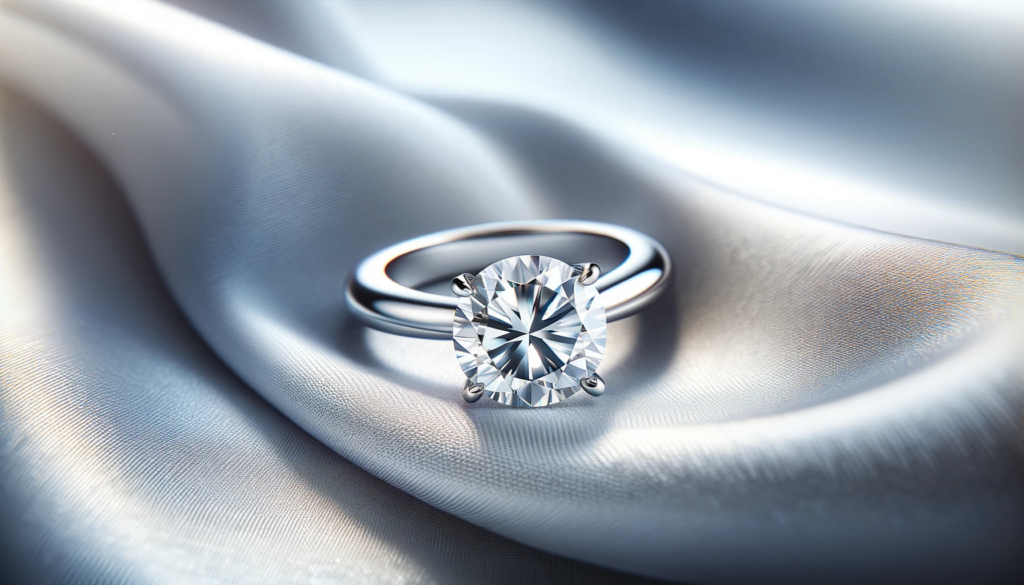
Composition and Characteristics of White Gold
White gold is a particular alloy of gold, which features a certain amount of nickel and zinc which, together, soften the gold’s natural yellow coloration to something much closer to white. It is plated in rhodium, for additional strength and shine.
One of the most appealing features found in white gold is its unique hue. Alone, this metal appears to be a whitish silver but, if you were to compare it with the dazzling purity of platinum, you would notice a slightly warmer quality to the white gold. This is, of course, down to the high presence of gold, which creates a very vague, yellow undertone many prize.
The nickel and zinc also make white gold significantly stronger than pure gold. It is generally available in 18 karats and 14 karats, with 14 karat white gold representing the stronger and paler of the two.
Understanding the Alloy: What Makes White Gold?
All gold mined from the earth is yellow. A naturally occurring white gold is as unlikely as a naturally-occurring rose gold. That does not, however, undermine its significance – or the prestige of owning a real gold ring.
White gold tends to be alloyed with nickel, palladium, and silver, although the types of alloys (and the amount of alloying metal used) will vary.
The Role of Rhodium Plating in White Gold’s Aesthetics
White gold is almost always dipped in rhodium. This disguises the warm, yellow hint that remains, even after the gold has been alloyed. Rhodium plating will need to be replaced every year or so, but this is a quick and easy process.
White Gold’s Popularity in Engagement Rings
White gold offers the beauty, luster, and strength of platinum at a much lower cost, making it the perfect choice for many shoppers looking to invest as much as possible into their diamond.
In any engagement ring, the diamond will inevitably take the lion’s share of any budget – whether you’ve got tens of thousands of dollars to spend, or a more definitive sum. We generally advise that the ring setting – one designed and created by a skilled jeweler – will take around 15% to 20% of the budget, though, obviously, factors like time and materials used will swing it one way or the other.
White Gold vs. Platinum
Platinum is a pretty easy way to drive the cost of even a simple ring design significantly higher – as much as 50% higher compared to the same setting cast from white gold.
And, unless you’re scrutinizing both metals very closely, you’re not going to spot the difference between the two rings, meaning you have the opportunity to invest even more money into your diamond.
For those working to a very specific budget, then, white gold offers a lot more freedom to invest in a higher quality – or slightly larger – diamond.
Comparing Durability, Cost and Appearance with Platinum
In theory, white gold is beautiful – it’s strong, bright and a genuine rival to the far more expensive platinum. But how does it shape up to other metals used in engagement rings?
Daily Wear
Unlike pure gold, white gold has been strengthened with alloy and is far less vulnerable to being scratched, warped, bent, or broken than 24k gold.
You don’t need to worry about a 14k or 18k white gold ring – it can withstand plenty of wear and tear over the years, making it a great option if you don’t want to pay the high price for platinum.
Due to the higher volume of alloy, a 14k white gold ring will inevitably prove a bit more robust and durable than 18k. Plus, while shoppers looking for yellow gold are often eager to preserve as much of the bright, yellow glow of pure gold as possible by opting for a higher karat like 18k, those looking for white gold don’t have that same problem.
Appearance
Both options will appear intensely white, and be indistinguishable from one another.
This is down to the rhodium plating used to enhance the color and durability of white gold. It lends an additional, bright sheen to the metal which gives it that distinctively cool, mirror-like appearance.
As we mentioned above, the difference between a 14k and 18k yellow gold is much more significant and will influence the vividity of the ring. This can lead to many shoppers opting to invest more into their ring setting, in order to capture the brightness of 18k gold alongside the brightness of the diamond.
If you’re looking for white gold, on the other hand, then paying extra for the higher karat isn’t likely to prove worthwhile.
Platinum will probably appear less scratched after years of wear, but replacing the rhodium plating will mean you can keep your white gold ring looking new and bright.
Value
As we mentioned above, it is simply impossible for you to get ‘pure’ white gold. It doesn’t occur naturally in nature, and can’t be achieved without alloying pure gold with specially chosen metals. This means that white gold generally comes at a much more affordable price than platinum.
But, if we’re talking about 14k white gold vs 14k gold, or 18k white gold vs 18k gold, white gold is not worth more (or less), and any differences in value between two similar rings will be marginal – and likely down to popularity, more than the market value of the two metals.
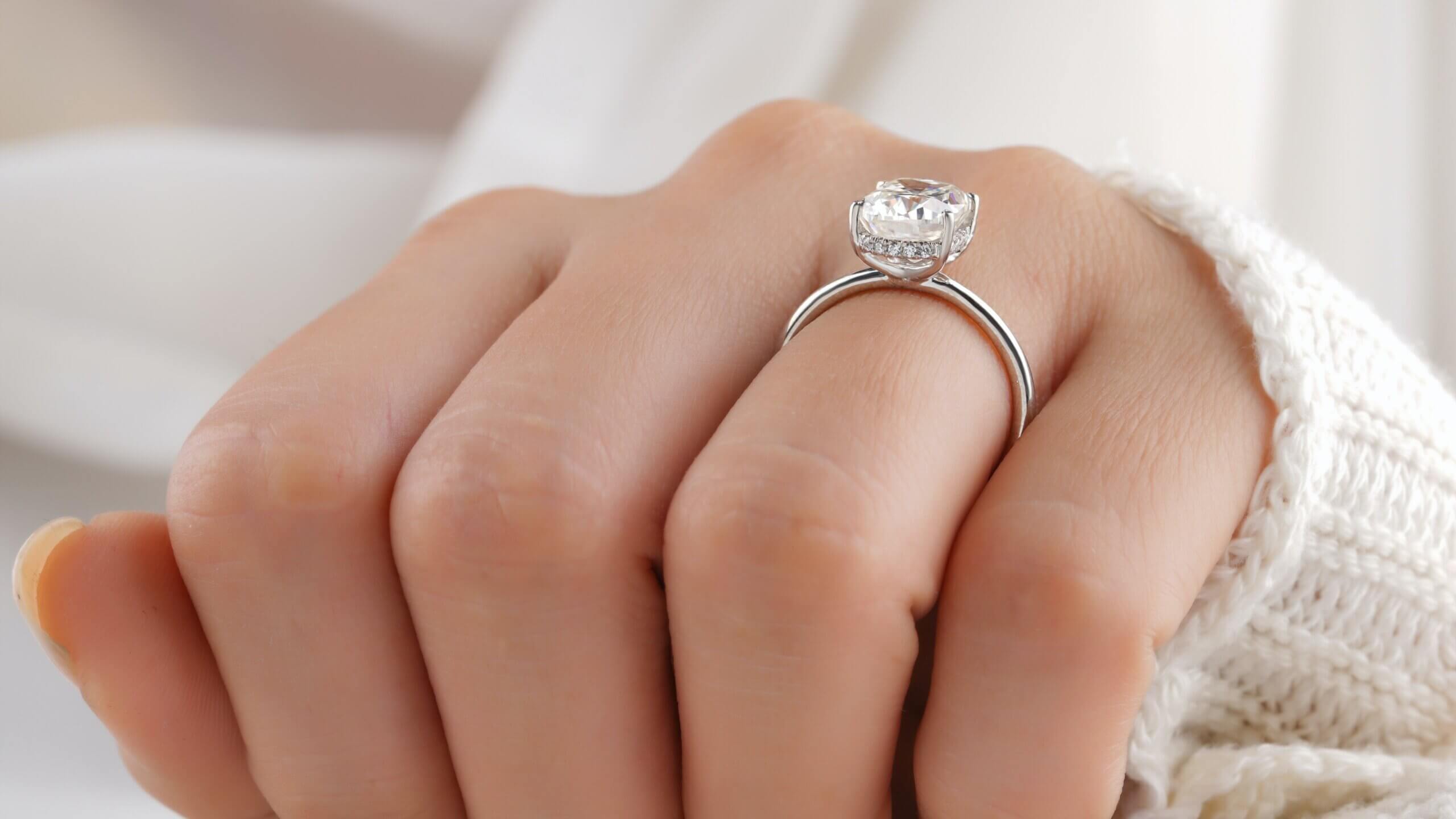
Caring for White Gold
At home, white gold doesn’t need any more care than yellow gold. Regularly soaking your ring in mild dish soap and warm water will remove any build-up of hand cream, soap, makeup, or dirt that may have begun to dull its sheen over time.
You can check out our full guide to caring for a diamond ring here.
While a white gold ring will last for many, many years, it will require new rhodium plating every three to four years, if you intend on wearing it daily.
This is, of course, a very minor task if you want to retain that beautiful, fresh-out-the-box shine of your engagement ring. What’s more, this is actually less upkeep than what is required to keep platinum looking bright and smooth and a satisfying way to restore that sense of ‘newness’ to your jewelry.
Our Expert Take
White gold is an excellent choice if your future bride favors the bright, modern look of sterling silver and platinum, but you’re looking to find the perfect sweet spot between affordability, durability, and beauty.
Sterling silver is softer, and more prone to being bent out of shape. When you take into consideration the fact that your engagement ring will be solely responsible for keeping that $10,000 diamond in place while your fiancée shops, works, rifles through her handbag, rides the subway (and everything else she does in a day), using sterling silver quickly becomes a definitive ‘no’.
This is why platinum is so popular, but it’s also expensive and, even in relatively simple designs, easily pushes shoppers out of their budget.
This is why white gold will always represent a brilliant choice for bridal jewelry. Keeping the prestige of gold, but offering a totally new look for brides that favor brighter metals, it’s a great metal to turn to when you start designing your ring.
8 FAQs
- Q: What Is White Gold Made Of?
- A: White gold is an alloy of pure gold and white metals like nickel or palladium, often coated with rhodium for added strength and shine.
- Q: How Often Does a White Gold Ring Need Replating?
- A: Typically, white gold rings require replating every 1-3 years, depending on wear and the thickness of the rhodium coating.
- Q: Can White Gold Turn Yellow Over Time?
- A: Yes, white gold can develop a yellowish tint as the rhodium plating wears off, revealing the natural color of the gold alloy.
- Q: Is White Gold More Expensive Than Yellow Gold?
- A: The price is usually similar, but it can vary depending on the purity of the gold (karat) and the cost of additional processes like rhodium plating.
- Q: Are White Gold Rings Hypoallergenic?
- A: Not always. If alloyed with nickel, white gold can cause allergic reactions in some people. Palladium-alloyed white gold is a hypoallergenic alternative.
- Q: Can I Wear My White Gold Ring Every Day?
- A: Yes, white gold is durable enough for daily wear, but it’s important to avoid exposure to harsh chemicals and extreme activities to prevent damage.
- Q: How Do I Clean My White Gold Engagement Ring?
- A: Use a solution of mild dish soap and warm water, gently scrubbing with a soft-bristle brush, and dry with a lint-free cloth.
- Q: Does White Gold Hold Its Value?
- A: White gold retains value similar to other types of gold, depending on the gold market and the condition of the ring.
Find your perfect white gold engagement ring with Jeweler AI – where elegance meets personalization.
FOLLOW-UP GUIDE SERIES

